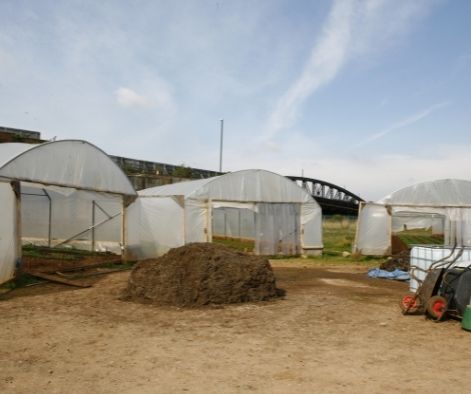Polytunnels are basically large-scale cold frames, giving growers more area to protect to extend the growing season. They are hoops covered with layers of fabric or plastic sheeting for protection from the elements and to better control the growing environment outside of the normal growing season. Polytunnels are less expensive and more flexible than greenhouses (having no foundations), but following polytunnel growing best practices can lead to an equal amount of yield.
Polytunnels are generally unheated structures but can be used with heating and cooling units. There are various versions of polytunnel structures, including high tunnels and low tunnels, and they are also called hoop houses or polyhouses. One of the main differences between polytunnels and greenhouses is that greenhouse plants are usually grown in nursery pots or greenhouse pots but plants in polytunnels can also be grown in the ground.
Why Use a Polytunnel
A better-controlled growing environment than open-field growing means lower labor and operating expenses, as higher yields and healthier plants increase efficiency and profitability. Not only that, but the U.S. Department of Agriculture found that hoop houses help growers meet the demand for fresh locally grown produce by enabling better growing management in all areas, soil, water, and nutrients.
Polytunnels are used to increase crop yield by extending the growing season. The structure provides frost and freeze protection for almost a month at the beginning and end of normal growing seasons, allowing growers to plant earlier and harvest longer. The protection that polytunnels provide for field-grown plants and crops means they are healthier and not subject to wind and rain damage. Another huge benefit is enabling the cultivation of high-value crops outside of their normal climate zones.
Best Placement for Polytunnels
Locations with level ground with good soil and drainage are ideal for polytunnel placement. However, if the location is convenient for access and other growing conditions but has poor soil, soils can be amended with cover crops or the addition of organic material. A site with access to water in all seasons is important. Polytunnels should be in full sun for the best growing results, but highly exposed open areas may pose problems from wind damage, requiring extra anchoring and bracing.
What to Grow in Polytunnels
If you have fruit crops or in-demand gourmet crops that command premium prices, polytunnel growing makes sense to protect and increase your harvests. Growers recommend focusing on the highest-value crops for polytunnel growing to maximize cost and profit ratios.
Most crops, from flowers to vegetables and leafy greens to fruits can be grown in polytunnels but when growers can offer harvests in early spring or late fall or winter when seasonal growing is more limited, they can command premium prices and profits.
Melissa Pasanen, writing for the Rodale Institute, reminds growers that crop rotation is necessary for managing soilborne diseases and pests, so using at least two polytunnels is helpful for the best growing conditions.
What can you expect from polytunnel growing? Michigan State University’s study of hoophouse impact on growers found the average payback range for polytunnels to be 4.4 years. That’s a pretty reasonable rate of return on the expense of building a polytunnel to the time it takes to earn back the investment for it.

